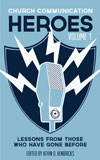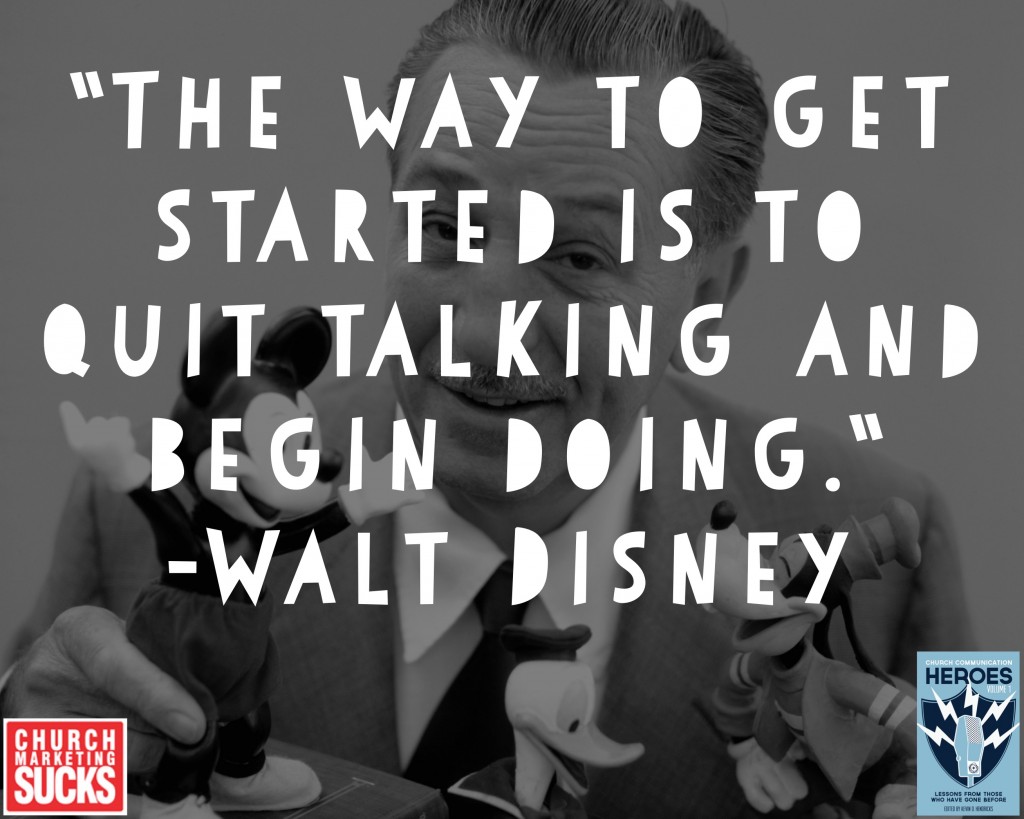“The way to get started is to quit talking and begin doing.” -Walt Disney (1901-1966)
I wonder how many people we’d reach if more churches embraced the teachings of Walt Disney.
When asked to write an article on my favorite “church” communicator, Disney immediately came to mind. No, he didn’t lead or start any churches that I know of and quite frankly, I’m not even sure if he was even a Christian (Editor’s Note: Yes, Disney was a Christian, at least in a nominal sense). But his philosophy is deeply woven into much of what I’ve been teaching church leaders over the past 17 years about how to reach people more effectively. The connections seem so obvious to me…
When I think of Walt Disney, these thoughts flood my mind: Vision. Imagination. Dare to dream big. Sweat the small stuff. Create an experience. Be committed to excellence. Always have the big picture in mind. Take risks. A passion to tell stories. Strong desire to bring families together.
Actions speak louder than words. Which means as communicators it’s not just about what we say but what we do. So let me unpack a few of these principles I learned from Walt that make my heart beat fast:
1. Create an experience.
People remember 10% of what they read but 100% of what they feel: Experiences matter. Disney went to great lengths to ensure park guests engaged in an experience and let nothing inside the park conflict with the magical world he intended to create.
If you were cut off in the church parking lot, had a painful process of checking your kids into the children’s ministry and were reprimanded for bringing coffee into the sanctuary, does it matter that “Love your neighbor,” was this week’s message? Ensure the experience is consistent with who you are and what you want to be known for both in and outside the church.
2. Always have the big picture in mind.
Disney was a master of planned design. Do the communication efforts of your ministries work together or are they unintentionally competing with each other for the attention of your congregation? If everything speaks at the same time at the same volume, nothing will be heard. Be intentional about how everything fits together.
3. Be committed to excellence.
Disney didn’t settle for second best and recognized details matter. God himself commanded the best sculptors, cedar and finest furnishings when the tabernacle was built. So why do we think it’s OK to settle for second best when people’s eternities are at stake?
4. Dare to dream big.
Disney was an innovator. “Steamboat Willie” was the very first animated film to have synchronized sound in 1928. In 1937, “Snow White” was the first full-length animated feature (also the first in English, first animated feature in Techincolor and first made in the United States)
. Walt Disney World itself was one-of-a-kind in many ways and didn’t even open until after his death As the story goes, someone asked Walt Disney Studios Creative Director Mike Vance if he was disappointed Walt didn’t get to see the end result. “He already did,” he replied. “That’s why it’s here.”
Walt Disney wasn’t afraid to take risks, loved to tell stories and has impacted generations on a global scale. We get to tell the greatest story ever told, yet time and again I see the fear of failure hold churches back—content with mediocrity. Marketplace companies have R&D labs. Why don’t we? When was the last time your church truly pushed the envelope knowing it would make some people unhappy? Don’t let the comfort of your congregation limit the vision God may have for your ministry.
What a Mouse Has To Do With Ministry
At the end of the day, our goal as church communicators is to do much more than just provide a magical experience. Eternities are at stake. But if we can do everything possible to remove barriers so it’s easier for people to connect with God, we may just have the happiest places on earth after all.
 More:
More:
- Learn more about heroes in our ebook, Church Communication Heroes Volume 1: Lessons From Those Who Have Gone Before.
- Check out other heroes in our Church Communication Heroes series.






Mark
July 3, 2012
Just to make sure the air remains clear:
http://www.cartoonbrew.com/disney/why-walt-disney-is-a-jew-hating-hitler-loving-racist.html
Dawn Nicole Baldwin
July 6, 2012
Thanks for jumping in the conversation, Mark. I think the first line of the article you posted sums it up well,
“The “Walt Disney hated Jews and blacks” accusation is one of the most vile mistruths tossed around about the old man, yet a quick browse on-line suggests that more young people believe it today than ever before. How did this happen?”
I’m not sure why (along with the article’s author) so many people believe this misperception, but the post does a good job of trying to sort out the reasons & uncover the truth.
Gretchen Hastings
July 5, 2012
Could I please post this or a link to it in the Florida Conference UMC Conversations section of our e-magazine? Thanks, Gretchen Hastings, Director of Communications, Florida Conference UMC
Dawn Nicole Baldwin
July 6, 2012
Thanks, Gretchen. If it’s okay with the CMS powers that be, it’s okay with me.
Kevin D. Hendricks
July 9, 2012
Just hit you up with an email, Gretchen. We can talk logistics there. Thanks!
Marc
July 11, 2012
I posted a similar blog last year about Disney and leadership….
take a look!
http://ecclesiamind.com/2011/03/01/walt-disney-on-leadership/
Dawn Nicole Baldwin
July 13, 2012
Very cool! Great minds think alike :)
Phil
February 24, 2014
Nice to see Uncle Walt used in association with the call for creating quality experiences and the pursuit of excellence. His was a wonderful model to follow.
It would be great to especially see the pursuit of excellence played out with music. It often seems that “good enough” is good enough. Creating a quality experience that is more inclusive seems many times to be taken as worldly or as exhibiting a lack of faith. When in the Psalms, God tells musicians to play skillfully, I don’t think that’s a suggestion. Seems more like something important that He wants us to do. The potential that the worship experience itself has to impact hearts and lives is almost unimaginable. Yet, this amazing gift is many times used merely as a transition from one part of the service to another.
I like the part about strategizing what’s important in communications as well. The right volume for the right message at the right time. Good stuff. Thanks for sharing your thoughts.